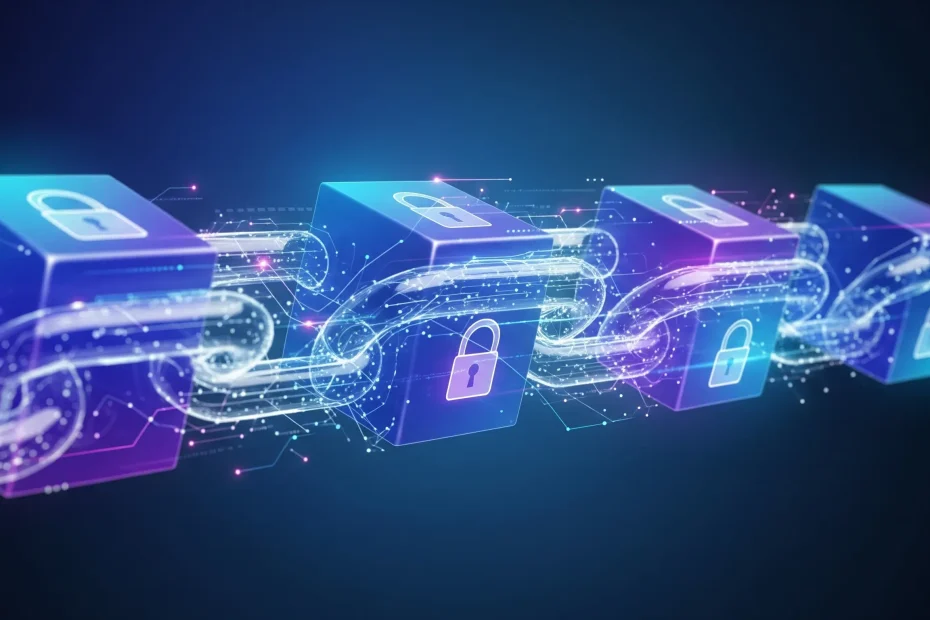Demystify Blockchain Technology. Learn how it works, its Real-World Applications beyond Crypto, and How it’s transforming Industries from Supply Chains to Healthcare. Discover the Pros, Cons, and its Impact on Businesses and Data Security in 2025.
Blockchain Unveiled: Powering Trust and Innovation in the Smart Digital Age
In a World Increasingly driven by Digital Interactions, the Need for Secure, Transparent, and Immutable Systems has never been Greater. Enter Blockchain – a Revolutionary Technology that has Moved Far Beyond its Cryptocurrency Origins to become a Foundational Layer for Innovation across Countless Industries. For Businesses and Individuals alike, Understanding Blockchain is no Longer Optional; it’s Essential for Navigating the evolving Digital Landscape of 2025 and Beyond.
This Comprehensive guide will Demystify Blockchain, Exploring its Core Mechanics, Diverse Applications, and Profound Implications for Trust, Data Security, and Business Efficiency. Whether you’re a Curious Individual, a Small Business Owner, or an Enterprise Leader, prepare to Uncover how this distributed Ledger Technology is reshaping Our Future.
What is blockchain and how does it work?
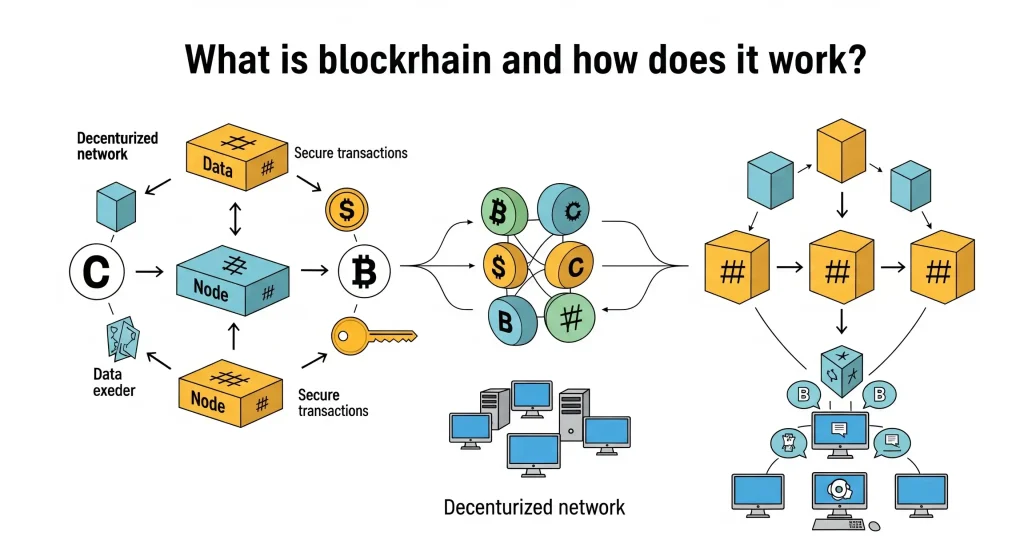
At its Core, a Blockchain is a Distributed, Immutable Ledger that Records Transactions in a Secure and Transparent Manner. Imagine a Digital Ledger that isn’t controlled by a Single Entity, but rather by a Network of Computers (Nodes) Spread across the Globe. Each “Page” of this Ledger is a “Block” Containing a Batch of Verified Transactions. Once a Block is filled with Data, it is Cryptographically Linked to the Previous Block, Forming a “Chain.”
The “Magic” lies in Several Key Principles:
- Decentralization: No Single Central Authority controls the Network. Data is Replicated and Stored across All Participating Nodes.
- Immutability: Once a Transaction is recorded in a Block and Added to the Chain, it cannot be Altered or Deleted. Any Error requires a New Transaction to Reverse it, with Both Visible.
- Consensus Mechanisms: Before a New Block can be Added, the Majority of the Network’s Participants must Agree that the Transactions within it are Valid. Popular Mechanisms include Proof of Work (PoW) and Proof of Stake (PoS).
- Cryptography: Each Block contains a Unique Cryptographic “Hash” of its Own Data and the Hash of the Previous Block. This creates a Secure, Tamper-Proof Chain; Changing any Data in a Block would Alter its Hash, Invalidating all Subsequent Blocks and Immediately Alerting the Network.
How is blockchain different from traditional databases?
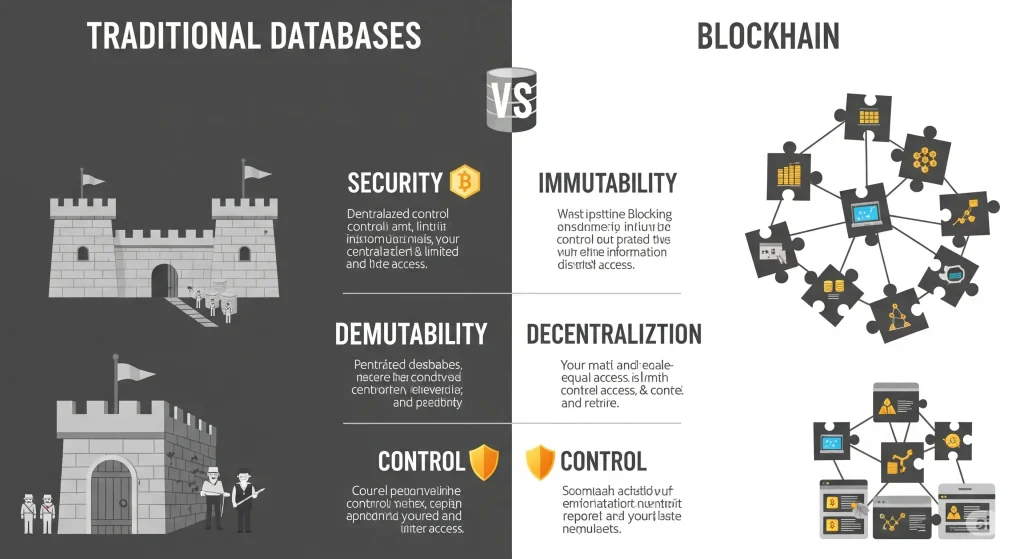
While both Blockchain and Traditional Databases Store Data, their Fundamental Architectures and Operational Principles are Vastly Different:
| Feature | Traditional Database | Blockchain |
| Control | Centralized (Managed by One Entity) | Decentralized (Distributed across a Network) |
| Immutability | Data can be Altered, Updated, or Deleted | Data, Once Recorded, is Immutable (Cannot be Changed) |
| Transparency | Access often Restricted, Permissions Controlled | Transactions generally Visible to All Participants |
| Security | Relies on Firewalls, Access Controls; Single Point of Failure | Cryptography, Decentralization, Consensus; Resilient to Single Attack Points |
| Trust | Relies on Trust in the Central Authority | Trust is Distributed and Mathematically Enforced |
| Consistency | Managed by Database Administrators | Maintained Automatically across all Distributed Ledgers |
What industries are using blockchain technology in 2025?
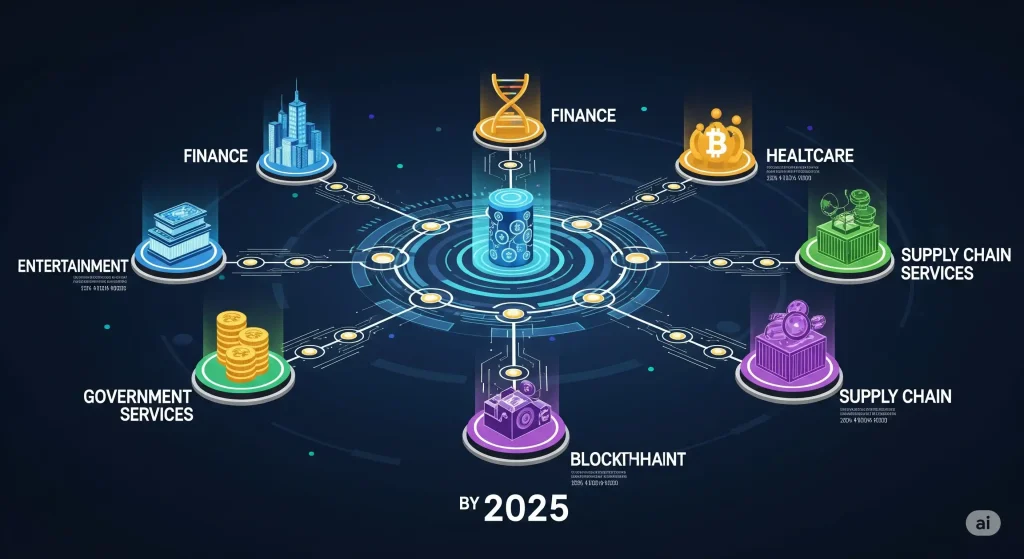
Blockchain’s Transformative Power is being Harnessed across a Wide Array of Industries in 2025, Far beyond Finance:
Finance & Banking: Streamlining Cross-Border Payments, Facilitating Digital Asset Trading, Decentralized Finance (DeFi), and Enhancing KYC (Know Your Customer) Processes.
Supply Chain Management: Providing Transparent and Immutable Tracking of Goods from Origin to Consumer.
Healthcare: Securely managing Patient Records, Facilitating Data Sharing with Patient Consent, tracking Pharmaceuticals, and Verifying Medical Credentials.
Real Estate: Streamlining Property Transfers, Managing Land Registries, and Enabling Fractional Ownership.
Government & Public Sector: Secure Voting Systems, Digital Identity Management, Land Registration, and Public Record Keeping.
Gaming & Entertainment: Enabling True Digital Ownership of In-Game Assets (NFTs), Transparent Royalty Distribution, and Decentralized Gaming Platforms.
Energy: Managing Peer-to-Peer Energy Trading, Tracking Carbon Credits, and Optimizing Grid Management.
Automotive: Tracking Vehicle Ownership, Maintenance History, and Supply Chain for Parts.
Logistics & Shipping: Enhancing Traceability, Reducing Paperwork, and Improving Efficiency in Global Trade.
What are smart contracts and how do they work on blockchain?
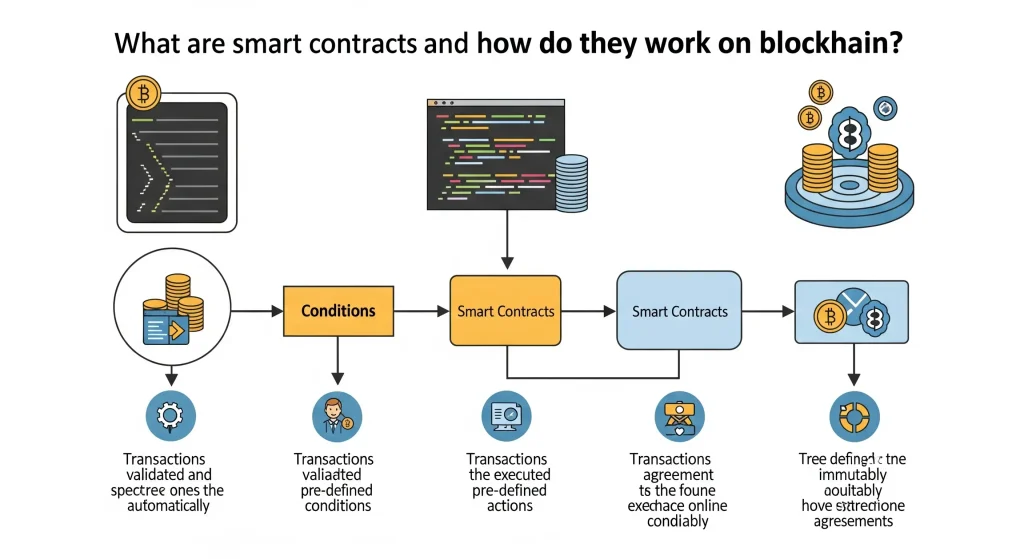
Smart Contracts are Self-Executing Contracts with the Terms of the Agreement Directly Written into Lines of Code. They run on the Blockchain, Automatically Executing when Predefined conditions are Met. Imagine a Vending Machine for Agreements: if you put in the Correct Money, it dispenses the Soda. Similarly, if the Conditions specified in a Smart Contract are Fulfilled, the Agreed-Upon Action (e.g., Releasing Funds, Transferring Ownership) is Automatically performed without the Need for Intermediaries.
They Work By:
Defining Conditions: Parties Agree on Terms and Conditions, which are then Coded into the Smart Contract.
Deployment: The Coded Contract is Deployed to a Blockchain Network.
Monitoring: The Blockchain Continuously Monitors for the Fulfillment of the Predefined Conditions.
Execution: Once Conditions are Met, the Smart Contract Automatically Executes the Agreed-Upon Action, and the Transaction is recorded on the Immutable Ledger.
Can Blockchain be Hacked or Manipulated?
While no System is Entirely Impervious, Blockchain is remarkably Resistant to Hacking and Manipulation, Especially Large, Well-Established Networks like Bitcoin or Ethereum. Its Inherent Security features make a Direct “Hack” of the Chain Itself Incredibly Difficult:
- Decentralization: There’s no Single Point of Failure. An Attacker would need to Compromise a Majority of the Network’s Nodes Simultaneously, which is Computationally Prohibitive for Large Networks.
- Cryptography: The Cryptographic Hashes Linking Blocks mean Altering one block would Require Re-Calculating the Hashes for All Subsequent Blocks in the Chain – a Monumental Task.
- Consensus Mechanisms: Any Attempted Alteration would be rejected by the Majority of the Network as Invalid. A “51% Attack” (where One Entity Controls over 50% of the Network’s Computing Power or Staked Assets) is Theoretically Possible but practically Unfeasible for Major Public Blockchains due to the Immense Resources Required.
However, it’s Crucial to Distinguish between Hacking the Blockchain Itself and Hacking Systems that Interact with Blockchain. Vulnerabilities often Exist In:
- User Wallets: If Private Keys are Compromised.
- Exchanges: Centralized Cryptocurrency Exchanges can be Targets.
- Smart Contract Bugs: Flaws in the Smart Contract Code can be Exploited.
- Phishing Scams: Tricking Users into Revealing Sensitive Information.
How can Blockchain Improve Supply Chain Transparency?
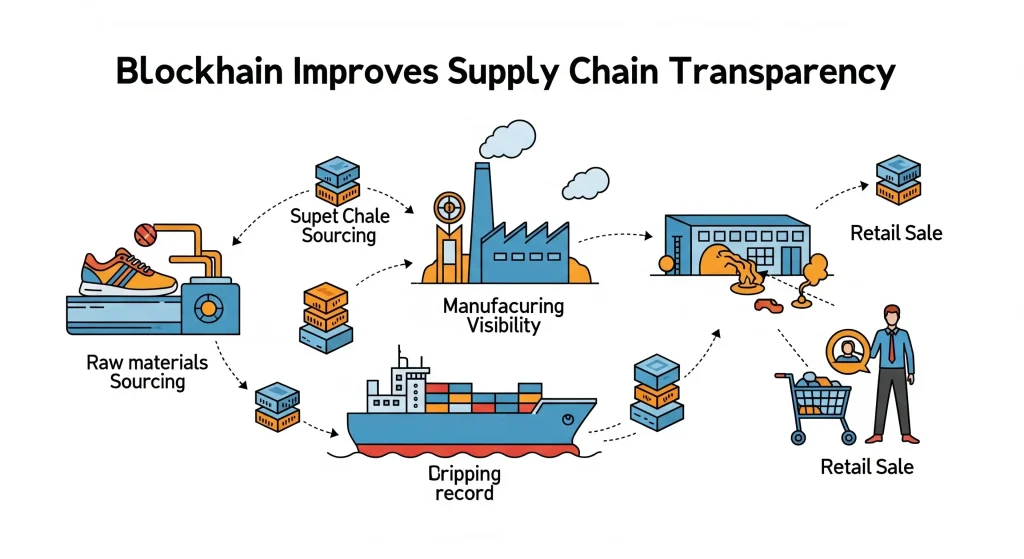
Blockchain offers a Revolutionary Solution for Enhancing Transparency in Supply Chains by creating a Shared, Immutable, and Real-Time Record of Every Product’s Journey.
End-to-End Tracking: Each Step of a Product’s Lifecycle – from Raw Material Sourcing, Manufacturing, Packaging, Shipping, to Retail – can be Recorded as a Transaction on the Blockchain.
Immutable Record: Once a Transaction (e.g., “Product X Left Factory A”) is Added, it cannot be Altered, Ensuring Data Integrity.
Shared Ledger: All Authorized Participants (Suppliers, Manufacturers, Logistics Providers, Retailers, and Even Consumers) can access the Same Up-to-Date Information, Eliminating Data Silos.
Fraud Reduction: It makes it Difficult to Introduce Counterfeit Goods, as their Origin and Movement can’t be Verified on the Chain.
Faster Dispute Resolution: Clear Audit Trails Enable Quick Identification of Where and When Issues Occurred.
Enhanced Consumer Trust: Consumers can Verify Product Authenticity, Ethical Sourcing, and Sustainability Claims.
What are the Real-World Applications of Blockchain beyond Cryptocurrency?
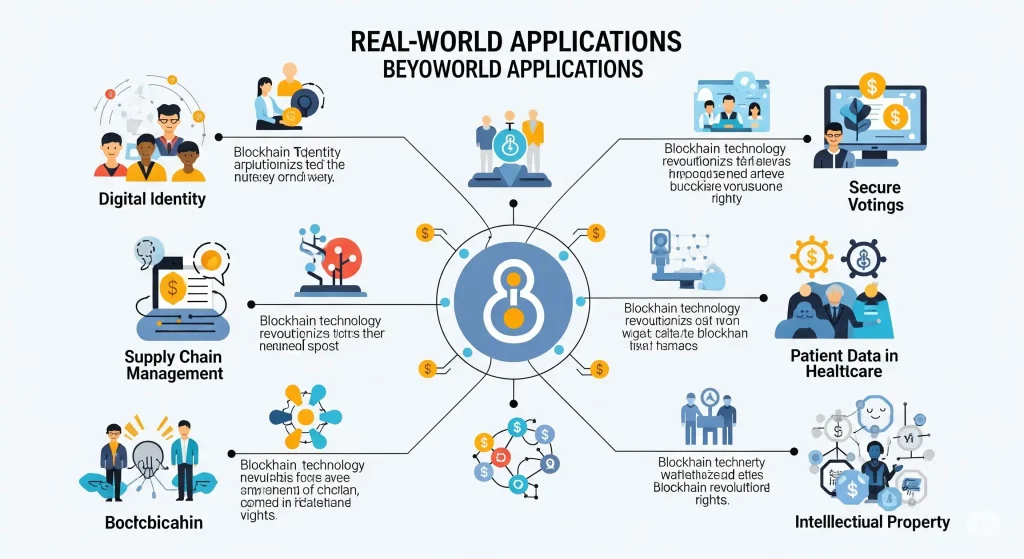
Beyond its role in Cryptocurrencies like Bitcoin, Blockchain’s Real-World Applications are Vast and Impactful:
- Digital Identity Management: Securely Storing and Verifying Personal Identities, Reducing Fraud and Simplifying Online Interactions.
- Voting Systems: Creating Transparent, Verifiable, and Tamper-Proof Election Processes.
- Intellectual Property Rights: Timestamping and Proving Ownership of Creative Works, Combating Plagiarism.
- Asset Tokenization: Representing Real-World Assets (like Real Estate, Art, or Commodities) as Digital Tokens on a Blockchain, Enabling Fractional Ownership and Easier Transfer.
- Carbon Credit Tracking: Ensuring Transparent and Verifiable Tracking of Carbon Emissions and Credits.
- Digital Notarization: Providing Immutable proof of Existence for Documents and Digital Records.
- Royalty Distribution: Automating and Ensuring Fair and Transparent Distribution of Royalties to Artists and Creators.
What are the Pros and Cons of Blockchain in Business?
Pros:
- Enhanced Security: Highly Resistant to Fraud and Unauthorized Access due to Cryptography and Decentralization.
- Increased Transparency: A Shared, Immutable Ledger Provides Visibility to all Authorized Participants.
- Improved Efficiency: Automation through Smart Contracts and Elimination of Intermediaries can Streamline Processes.
- Reduced Costs: Lower Transaction Fees and Reduced need for Third-Party Verification can Lead to Savings.
- Greater Trust: Builds Confidence Among Parties who may not Otherwise Trust Each Other Directly.
- Disruption Potential: Opens Doors for New Business Models and Services.
Cons:
- Scalability Challenges: Many Blockchain Networks Struggle with Processing a High Volume of Transactions Quickly.
- High Energy Consumption: Some Consensus Mechanisms (like Proof of Work) require Significant Energy.
- Regulatory Uncertainty: The Legal and Regulatory Landscape is Still Evolving, Creating Ambiguity.
- Complexity & Integration: Implementing and Integrating Blockchain Solutions can be Complex and Expensive, Requiring Specialized Expertise.
- Immutability Drawbacks: Once Data is on the Chain, it’s difficult to Correct Errors or Comply with “Right to be Forgotten” Regulations.
- Storage Limitations: As the Ledger Grows, Storing a Full Copy on Every Node can become Resource-Intensive.
How Secure is Blockchain for Storing Personal or Business Data?
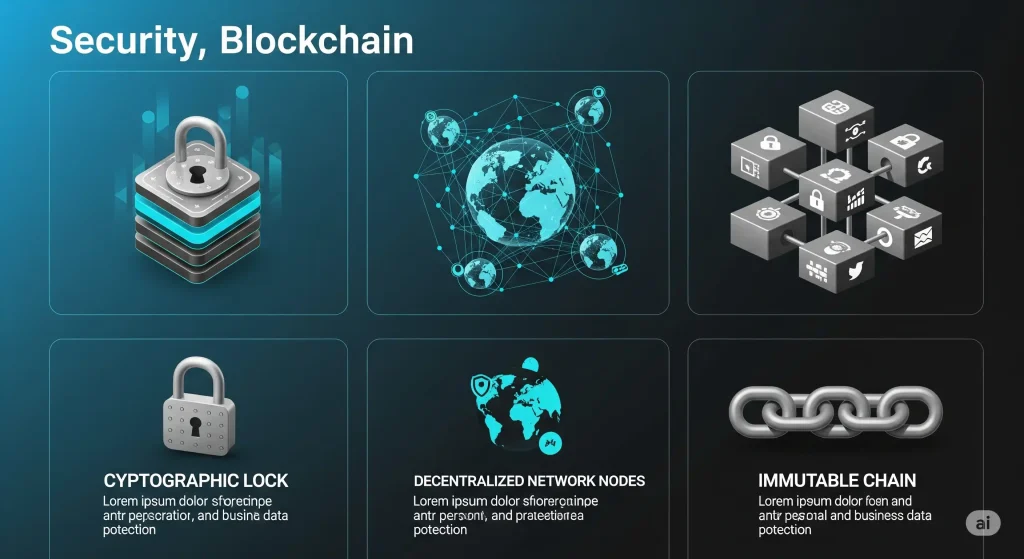
Blockchain offers a High Degree of Security for Storing Personal or Business Data, Particularly when compared to Traditional Centralized Databases. This Security Stems from:
- Cryptographic Hashing: Each piece of Data is Hashed, Creating a Unique Digital Fingerprint. Any Alteration changes the Hash, Invalidating the Data.
- Decentralized Storage: Data is distributed across Multiple Nodes, Eliminating a Single Point of Failure that Hackers could Target.
- Immutability: Once Data is Recorded and Verified, it’s Virtually Impossible to Tamper with.
- Public-Key Cryptography: Users have Private Keys (for Signing Transactions and Controlling Assets) and Public Keys (for Identification). This Ensures only Authorized Parties can Access or Modify their Specific Data.
However, it’s Important to Differentiate:
- Data on the Public Blockchain: For Truly Sensitive Data, Storing it directly on a Public, Permissionless Blockchain isn’t Ideal due to its Public Nature. Instead, Cryptographic Hashes or References to Off-Chain Data are Often Stored on the Blockchain, While the Sensitive Data Itself is Stored Securely Off-Chain with Access Controlled by Blockchain-Based Permissions.
- Private/Permissioned Blockchains: For Businesses, Private or Permissioned Blockchains Offer Enhanced Privacy and Control. Only Authorized Participants can Join the Network and Access Specific Data, Balancing Decentralization with Confidentiality Requirements.
How can Small Businesses Benefit from Blockchain Integration?
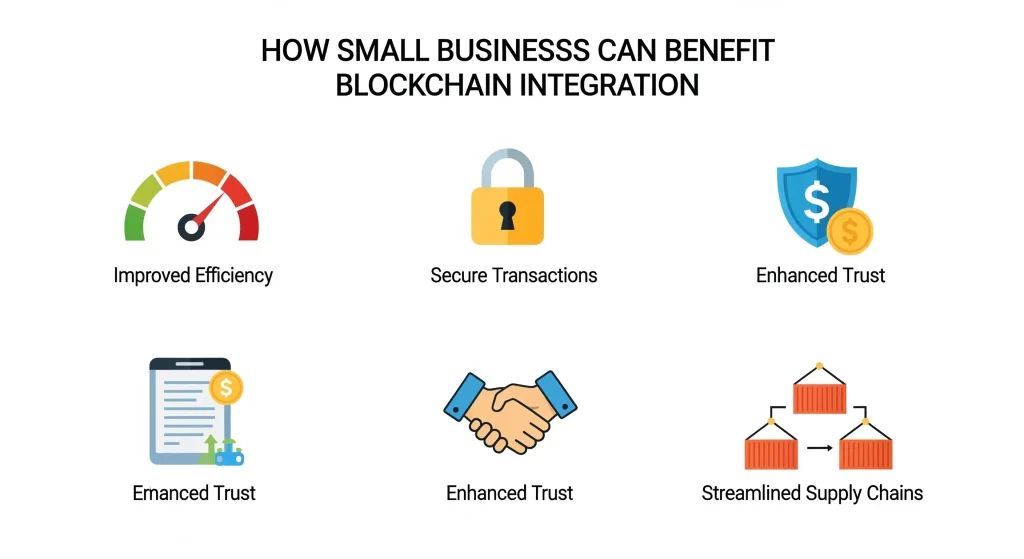
Small Businesses might Initially View Blockchain as Complex or Costly, but Strategic Integration can offer Significant Benefits:
Enhanced Trust & Transparency: Build Stronger Relationships with Customers and Partners by Offering Verifiable Proof of Product Authenticity, Ethical Sourcing, or Service Delivery. This is a Huge Differentiator.
Streamlined Operations: Automate processes with Smart Contracts (e.g., Invoice Payments, Escrow Services), Reducing Administrative Overhead and Human Error.
Improved Supply Chain Management: If dealing with Goods, Gain Better Visibility into Product Origins and Movement, Improving Inventory Management and Reducing Fraud.
Secure Data Management: Explore Blockchain Solutions for Secure Record-Keeping (e.g., Legal Documents, Customer Agreements) to Enhance Data Integrity and Compliance.
Reduced Transaction Costs: For International Payments or Specific Financial Services, Blockchain can Offer Lower Fees and Faster Settlement Times than Traditional Banking.
New Business Models: Explore Tokenization of Assets, Loyalty Programs using Digital Tokens, or Participation in Decentralized Marketplaces.
Fraud Prevention: Mitigate Risks of Fraud in Transactions, Identity Verification, and Intellectual Property.
